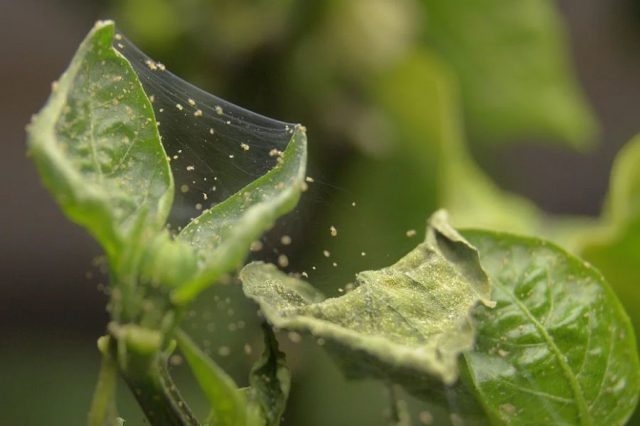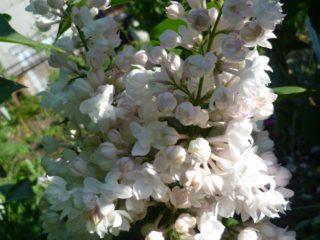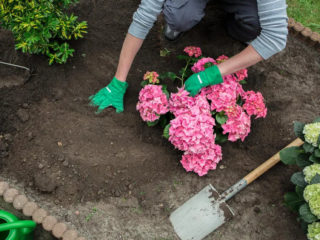Content
- 1 Description of herbaceous hibiscus with photo
- 2 Varieties of herbaceous hibiscus with photos and names
- 3 When and how to plant herbaceous hibiscus in open ground
- 4 How to care for herbaceous hibiscus in the garden
- 5 Reproduction of herbaceous hibiscus
- 6 Diseases and pests of herbaceous hibiscus
- 7 Photo of herbaceous hibiscus in landscape design
- 8 Conclusion
Herbaceous hibiscus is an ornamental plant for a summer cottage with lush flowering. Before planting a crop, you should familiarize yourself with the basic rules of care.
Description of herbaceous hibiscus with photo
Herbaceous hibiscus (Hibiscus moscheutos) is a perennial plant of the Malvaceae family. It has straight shoots up to 3 m high and powerful branched roots, shaped like tubers.
The leaves of herbaceous hibiscus are round or oval, wide, dark green in color. The buds can be simple, double or ruffled, with white, pink, red or dark purple petals.The decorative period begins in mid-July and lasts until the last days of October. Each of the plant's buds lives only about a day, but fading flowers are immediately replaced by new ones.
In its natural form, the shrub is found in the subtropical regions of North America. The plant is grown artificially all over the world in garden plots.
Varieties of herbaceous hibiscus with photos and names
The outdoor plant herbaceous hibiscus is represented by a large number of ornamental varieties. There are several varieties that are most popular among gardeners.
Copper King
The Copper King variety grows to an average height of 1.2 m above the ground. It has large leaves, shaped like maple leaves; depending on the air temperature, it can change its color from dark green to copper-red. It blooms with white-pink buds with bright stripes on the petals and a purple center. The flowers can reach 40 cm in diameter.
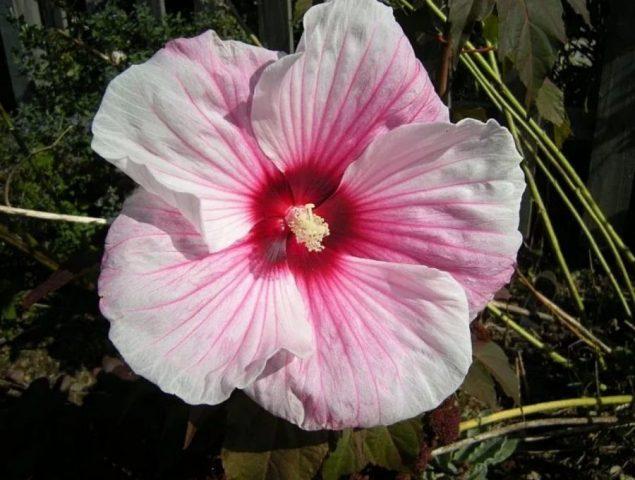
Copper King has increased frost resistance down to -35 ° C
Youth
The shrub up to 1.5 m above the ground has light green leaves with a yellowish tint. The plates are finger-shaped and consist of 3-5 segments. During the flowering period, the variety produces pinkish-white buds.

Flowers of the herbaceous hibiscus Youth can reach 10 cm in diameter
Old Yella
The Old Yella variety is a low shrub up to 1 m above the ground. It has strong vertical shoots and feathery green leaves, which in the light can take on a purple hue. The flowers are large, up to 30 cm in diameter, with wavy edges. The petals of the buds are white or cream, the core is bright red.

Frost-resistant variety Old Yella is suitable for planting in the Urals and Siberia
Cranberry Crash
The Cranberry Crush variety rises up to 1.2 m above the ground. It has a rounded crown formed by green leaves with purple veins. The buds of the plant are deep burgundy with dark stripes on the petals. The variety is cold-resistant and tolerates drought well, suitable for planting in areas with an unfavorable climate.

The diameter of Cranberry Crush buds can reach 25 cm
Pink porcelain
Herbaceous hibiscus Pink-porcelain blooms with bell-shaped buds of soft pink color. The leaves are also responsible for the decorative appearance of the plant - they are light green with a yellow tint, and carved in shape. The shrub blooms from mid-summer to late autumn and tolerates winter well in the middle zone.

The Pink Porcelain variety grows up to 1.3 m in height
When and how to plant herbaceous hibiscus in open ground
Growing swamp hibiscus in open ground does not require much effort from the gardener. It is enough to follow the basic recommendations and provide the culture with basic care.
It is recommended to root swamp hibiscus in open ground in the spring no earlier than the end of May. In the northern regions, the procedure is often postponed to the beginning of June, since the final warmth sets in later. For the plant, choose a bright place on the site, sheltered from cold drafts; it is also allowed to plant the shrub in permeable partial shade.
Herbaceous hibiscus needs fertile and loose soil. The pH level can be neutral or slightly acidic. The shrub is not suitable for highly acidified or alkaline soil. Do not place herbaceous hibiscus in lowlands or on clay soil with poor aeration.
Planting an ornamental plant on a site is carried out according to the following scheme:
- The selected area is dug up properly and the soil is diluted with humus and sand.
- Prepare a hole for the seedling that is approximately twice the size of the root system.
- Fill the hole halfway with nutritious soil and spill it generously with warm water.
- Place the seedling in the center, spreading the roots to the sides.
- Fill the remaining voids with soil and water again.
In the first days after planting in open ground, herbaceous hibiscus is shaded from the bright sun. To ensure that moisture evaporates from the soil more slowly, the tree trunk circle can be immediately mulched.
How to care for herbaceous hibiscus in the garden
To grow your herbaceous hibiscus healthy and strong, you need to pay attention to basic care. The shrub needs to be moistened and fed on time, and also protected from diseases and pests.
Watering
Herbaceous hibiscus tolerates drought well, but only if it is short-lived. During periods of prolonged absence of precipitation, the plant should be regularly watered with lukewarm, settled water. You should focus on the condition of the soil at the roots and on the leaves of the bush. With a lack of moisture, the plates lose turgor and begin to dry out at the tips.

Watering herbaceous hibiscus is carried out in the evening.
Top dressing
Herbaceous hibiscus in the Moscow region and other regions requires regular fertilization. In the spring, it is recommended to use preparations containing nitrogen for fertilizing - they will help the plant gain green mass faster.At the beginning of summer and in August, the shrub needs phosphorus and potassium.
With the onset of autumn, feeding is completely stopped. The culture should go into a dormant state and prepare for wintering.
Trimming
Pruning of herbaceous hibiscus is carried out for sanitary purposes twice a year. In early spring and late autumn, all damaged, twisted and weak shoots are removed from the bush. The procedure will not only protect the plant from diseases, but also increase its decorative value.
Herbaceous hibiscus should be pruned for the winter approximately 2-3 weeks before the onset of cold weather. Haircuts are not carried out just before frost. In this case, the cuts will not have time to heal, and the bush will suffer.
Transfer
The shrub is capable of developing in one place for 15-20 years. But if the crop has grown too much and begins to bloom less abundantly, or the conditions in the old area have worsened, you can transplant the herbaceous hibiscus.
The procedure is recommended for bushes older than five years. It is best to transplant herbaceous hibiscus in the fall, about a month before the onset of cold weather. The plant must be carefully removed from the soil, rotten and dry areas of roots must be removed, and then the sections must be treated with a fungicidal solution. After this, the bush is transferred to a new hole and provided with standard care.
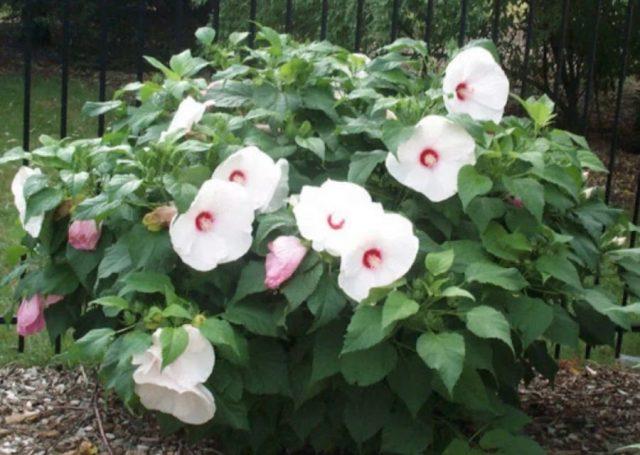
You can replant your herbaceous hibiscus in the spring, but in this case the plant will take root in its new location throughout the season.
Preparing herbaceous hibiscus for winter
Swamp hibiscus overwinters in open ground, but requires the creation of good shelter. In the fall, you need to wait until the above-ground part of the bush dries out completely and prune it.
Shortly before the onset of cold weather, the rhizome remaining in the ground is densely mulched with dry leaves, pine needles or humus in a layer of about 10 cm. The plant is covered with agrofibre or lutrasil on top, securing the material with boards or stones on the sides. If the winter is expected to be cold, you can additionally cover the bush with spruce branches. With the onset of spring, the shelter is removed after the end of frost.
Reproduction of herbaceous hibiscus
There are several ways to propagate herbaceous hibiscus. The plant responds well to seed and vegetative propagation, quickly takes root in the soil and does not create any special problems for the gardener.
Planting herbaceous hibiscus with seeds
Propagating herbaceous hibiscus by seeds takes a long time, but has its own advantages. In particular, seedlings obtained in this way are characterized by increased endurance and tolerate unfavorable growing conditions.
Planting crops for seedlings is carried out according to the following scheme:
- Wrap the seeds in damp gauze and leave at room temperature for about a week.
- After swelling, the grains are laid out on the surface of a loose substrate.
- Lightly sprinkle with soil and spray with warm water from a spray bottle.
- Before germination, remove the container with the seeds under the film in a warm place.
After green sprouts form, the cover is removed from the container. The box is moved to the sunniest window and the seedlings are grown at home until the beginning of summer.
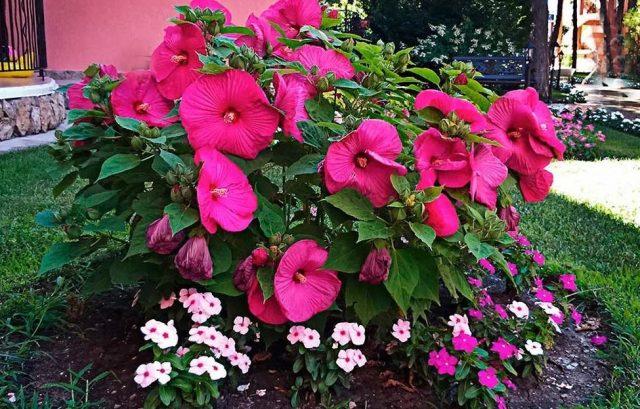
Herbaceous hibiscus from seeds blooms for the first time only after 3-4 years
Propagation of herbaceous hibiscus by cuttings
Cuttings of herbaceous hibiscus allow you to quickly and without unnecessary difficulties obtain a hardy ornamental plant on your site.Reproduction is carried out according to the following algorithm:
- In June, several young shoots about 15 cm long are cut from the top of the bush.
- Place the cuttings in water with the addition of a growth stimulator.
- After the white roots appear, the shoots are transferred to containers with nutrient soil.
- Cover the cuttings with plastic wrap or cut bottles for several weeks to create greenhouse conditions for them.
- After new leaves appear on the shoots, remove the cover.
Young plants are transplanted into open ground for the next season.
Dividing the bush
If you have to replant a herbaceous hibiscus in the fall, you can simultaneously carry out the division procedure for the shrub. Plants older than five years should be propagated in this way.
The algorithm is quite simple and looks like this:
- A few weeks before the cold weather, the crop is carefully dug out of the ground.
- Divide the bush along the rhizome with a shovel or sharp knife.
- The resulting seedlings are treated with anti-rotting fungicides.
- Place the plants in individual holes and water.
The procedure can also be carried out in early spring before flowering begins. Autumn division of the bush is practiced mainly in the Moscow region and southern regions.
By layering
Herbaceous hibiscus can be propagated in spring by layering. The procedure is performed as follows:
- Dig a small trench in the ground.
- The flexible lower shoot of the bush is placed in it, leaving the top above the ground.
- The layering is secured from straightening and covered with soil.
- Water generously.
Already in mid-summer, the cuttings will produce new green shoots. In the fall, the shoot can be separated from the main bush and moved to a new location.
Diseases and pests of herbaceous hibiscus
Herbaceous hibiscus generally has good immunity, but can suffer from some diseases and pests. The danger for him is:
- aphid - an insect that causes deformation and wilting of leaf plates;
Aphids feed on hibiscus plant sap and weaken the plant.
- spider mite - the pest entangles shoots and interferes with the normal development of herbaceous shrubs;
Spider mites are dangerous for hibiscus in hot, dry weather
- chlorosis - the disease develops due to a lack of nutrients in the soil and causes yellowing of the leaves.
For chlorosis, hibiscus needs to be fed with nitrogen and iron.
If the herbaceous shrub begins to wither and wither, it is worth carrying out sanitary pruning for it and treating the plant with copper preparations. A proper watering schedule can prevent the development of fungi; it is also important to apply fertilizing in a timely manner. When a bush is damaged by pests, homemade infusions with a strong odor, a solution of laundry soap and ready-made insecticides are used for treatment.
Photo of herbaceous hibiscus in landscape design
At a summer cottage, herbaceous hibiscus is most often placed alone against the backdrop of a green lawn in an open sunny area. When planted in this way, the shrub immediately attracts attention and decorates the garden. In addition, it gets the opportunity to develop freely without competing for nutrients with other plants.
You can place the crop close to other shrubs that do not have bright flowers. Against their background, hibiscus will look especially impressive. The culture is planted in the background of flower beds and mixborders to create a beautiful frame for them.

Spreading herbaceous hibiscus suitable for forming a hedge
Conclusion
Herbaceous hibiscus is a fast-growing ornamental crop with spectacular flowering and bright leaves. The shrub easily takes root in almost any climate and does not require complex care.

